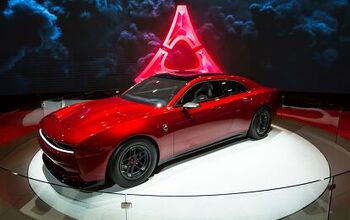At Home With The Toyodas - And A Mysterious Cherry Tree

Today, I went on a very early morning Shinkansen to Nagoya. The idea was to have me kind of certified as a Toyota-accredited journalist. I don’t know whether I qualified. I flunked the required rattling-off of the 12 Toyota plants in Japan. However, I was invited into Toyoda’s house.
Not Akio Toyoda’s house. His grandfather Kiichiro Toyoda’s house. He was the founder of Toyota. The house was built in 1933, and as you can see, the house would be just as much at home up the Hudson or in Georgetown as it is in the green hills near Toyota City.
What was interesting is what I found in the somehow unruly weeds next to the house: A little cherry tree. What makes a little cherry tree in Japan so interesting? A little sign. It says in Japanese and English: “Commemorating Toyota’s New Start.” And then a date: “2011-2-24.”
What happened on February 24, 2011? Not much. But what happened a year before? That’s right: Akio Toyoda took to The Hill and was grilled by Congress. A little bit less than a year later, on February 8, 2011, Toyota was formally exonerated. Nobody apologized. There wasn’t even a “thank you” for the three times $16.4 million the NHTSA had collected from Toyota.
It is fascinating that the congressional barbecue is remembered as a new start somewhere in the woods near Toyota City.

Bertel Schmitt comes back to journalism after taking a 35 year break in advertising and marketing. He ran and owned advertising agencies in Duesseldorf, Germany, and New York City. Volkswagen A.G. was Bertel's most important corporate account. Schmitt's advertising and marketing career touched many corners of the industry with a special focus on automotive products and services. Since 2004, he lives in Japan and China with his wife <a href="http://www.tomokoandbertel.com"> Tomoko </a>. Bertel Schmitt is a founding board member of the <a href="http://www.offshoresuperseries.com"> Offshore Super Series </a>, an American offshore powerboat racing organization. He is co-owner of the racing team Typhoon.
More by Bertel Schmitt
Latest Car Reviews
Read moreLatest Product Reviews
Read moreRecent Comments
- MaintenanceCosts Nobody here seems to acknowledge that there are multiple use cases for cars.Some people spend all their time driving all over the country and need every mile and minute of time savings. ICE cars are better for them right now.Some people only drive locally and fly when they travel. For them, there's probably a range number that works, and they don't really need more. For the uses for which we use our EV, that would be around 150 miles. The other thing about a low range requirement is it can make 120V charging viable. If you don't drive more than an average of about 40 miles/day, you can probably get enough electrons through a wall outlet. We spent over two years charging our Bolt only through 120V, while our house was getting rebuilt, and never had an issue.Those are extremes. There are all sorts of use cases in between, which probably represent the majority of drivers. For some users, what's needed is more range. But I think for most users, what's needed is better charging. Retrofit apartment garages like Tim's with 240V outlets at every spot. Install more L3 chargers in supermarket parking lots and alongside gas stations. Make chargers that work like Tesla Superchargers as ubiquitous as gas stations, and EV charging will not be an issue for most users.
- MaintenanceCosts I don't have an opinion on whether any one plant unionizing is the right answer, but the employees sure need to have the right to organize. Unions or the credible threat of unionization are the only thing, history has proven, that can keep employers honest. Without it, we've seen over and over, the employers have complete power over the workers and feel free to exploit the workers however they see fit. (And don't tell me "oh, the workers can just leave" - in an oligopolistic industry, working conditions quickly converge, and there's not another employer right around the corner.)
- Kjhkjlhkjhkljh kljhjkhjklhkjh [h3]Wake me up when it is a 1989 635Csi with a M88/3[/h3]
- BrandX "I can charge using the 240V outlets, sure, but it’s slow."No it's not. That's what all home chargers use - 240V.
- Jalop1991 does the odometer represent itself in an analog fashion? Will the numbers roll slowly and stop wherever, or do they just blink to the next number like any old boring modern car?







































Comments
Join the conversation
Cannot wait to ses how that tree get's cut down. Real grudges go down generations in East-Asian society.
Thanks for the amplifications Bertel. (I did also find somebody's comment about the english-subtitled tablet under the tree instructive and enlightening ... which aligns well with the adage: "with a message, always consider your audience" ... and wondered if the real message is "the only way to go forward, is by going back and honoring that which served us so well for so long...") I got to thinking about the whole "companies often fail in the 2nd or 3rd generation (because the values of the founder fail to become a transending theme because they fail to be imbued into his descendents, or the values themselves are not adaptable to change) thing. Was thinking about Krupp: - the family kept the little cabin of the founder in the Werksgelände, long after the earlier descendents had built Villa Hugel, or were sodomizing their boy toys on Capri, or the last descendent flying around in his Jet-Star and living a decadent lifestyle on Sylt and Rio (as the business, the family tradition, the legacy his father built-up for him; in short, his birth-right cratered into bankruptcy, restructuring, care-taker ownership, and a kind of GM-like rudderless existance... Then thought of Thyssen: - the old man found his success much quicker, restored a castle, rubbed elbows with Adenauer (German Chancellor), but in the end, the family devolved into a bunch of unhappy, squabbling, drunk collectors of often-derided, oftentimes minor, artwork. Or Carnegie (US-Steel), or the New York Central System (the pride of the Vanderbilts), or newer technologies that came after steel, connected with names like Westinghouse, Edison, or Bell, or that came after cars (like Douglas, McDonnel, Grumman, Northrup, Hughes, Lougheed, Wright, Curtiss, etc., or Galvin Mfg.) And all of the car companies, even with a much shorter time-span between the founder, the descendents who sold-out or were taken-over, and in the process whos founding families and principles have been washed out to sea over time... And it occurred to me, that Toyota is really very unusual, in that it is probably the most stable (from a DNA perspective) of all the companies with a family member somewhere in the management (like Ford, Peugeot, or holding shares like BMW or re-agglomerated like VW ) ... But, I am still wondering how Kiichiro-san's descendents are living today, do they have the little house on the hill sensibility, or have they also moved-on to the often G5-flying, mega-yacht sailing, sometimes scandal-sheet-sizzling-affair lifestyles of many of their competitor companies founding families? p.s. House looks like a japanese-interpretation of a swiss-style cottage... here's an austrian-interpretation of the swiss-cottage motif: http://www.feldkirch.at/stadt/bildergalerie/11.-mai-2011-besichtigung-der-parkanlage-margarethenkapf/img_5639.jpg